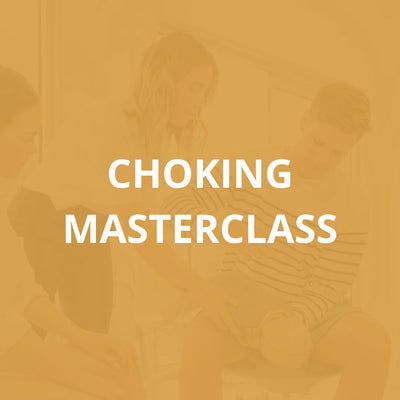Choking 101: Emergency First Aid
It is a developmental stage for babies to put everything in their mouth when they are little. Some toddlers like to explore this way, and sometimes kids just eat something that goes down the wrong way. No matter how it happens, choking is scary and life threatening. In this blog we will talk you through choking first aid so you can equip yourself to jump into action if your child starts to choke. It is very scary and confronting, but knowing what to do and what not to do can save your child’s life.
Choking first aid
From our previous posts we are now all experts in preventing our children from choking by knowing what to avoid and how to prepare our food safely to help prevent choking.
However, choking can still happen... it is scary and very confronting. Let's learn what to do so we can be confident in performing life saving choking first aid.
So what is actually happening when our kids are choking?
If you can imagine, when we breathe in, air enters our lungs via our trachea (windpipe)- this is where air goes in and out. Choking is when something foreign goes into the trachea instead of the oesophagus (food pipe), partially or fully obstructing this air movement and limiting our supply of oxygen. We need oxygen to keep our bodies alive, particularly the brain as it can only survive a few minutes without oxygen.
If the object is at the entrance of the trachea (epiglottis), a good cough will more than likely push it out.
Follow our guide to learn how to perform first aid if your child is choking. Remember to always call an ambulance if your child is having trouble breathing or is unconscious.
What do we do?
If your child is choking and STILL breathing (ie, an effective cough)
-
Encourage the child to cough. Infants and young children may cough instinctively. In many cases coughing will help dislodge the object
-
Stay calm and reassure your child
-
Continue to monitor for breathing until they recover
If coughing does not dislodge the object, if cough becomes less effective or your child stops breathing at any time call an ambulance- 000 and follow your first aid guidelines- remember DRSABCD.
If your child is choking and NOT breathing (ie, no effective cough).
Call an ambulance (000) Get your child in the age appropriate position.
- Infants (less than 1 year old) should be placed facedown, across your knees and held with their head lower than their chest

- Older children can sit and lean forwards if they are able, otherwise lie them down on the floor on their side (recovery position).


Once you have your child in their correct position
-
Give 5 sharp back blows with the heel of your hand, between the shoulder blades. The key here is to make them forceful, you are trying to dislodge something stuck in a tight spot- make it count. In between each back blow check to see if your child is still breathing or if the object has come out.
-
If these are unsuccessful, turn your child onto their back and give 5 chest thrusts, keeping your hand in contact with the chest at all times. Use the same position as you would for CPR (lower half of the breast bone) but slower and sharper movements. Once again check in between each chest thrust to see if your child is still breathing or if the object has been dislodged.

For infants (up to 12 months) use 2 fingers
For a child use the heel of your hand
-
If the blockage still has not cleared continue to alternate between 5 back blows and 5 chest thrusts until the ambulance has arrived.
-
If at any time your child becomes unconscious, start CPR.
Useful points
-
If your child is choking or having trouble breathing, call an ambulance immediately.
-
CPR can dislodge the object. If this occurs, place child on their side in the recovery position and clear their mouth of the object.
-
If at any time your child becomes unconscious- start CPR and call an ambulance (if you have not already done so).
-
Never use the Heimlich manoeuvre (forceful squeezing of the abdomens) as this can cause serious damage to internal organs.
-
Prevention is key. Use age appropriate toys, follow guidelines for safe foods and equip yourself with first aid knowledge
-
After treating your child successfully they still may need medical help if: you are worried about them, they have a cough that doesn’t go away, or they feel like something is stuck in their throat.
Useful Resources
This ANZCOR Foreign Body Airway Obstruction (Choking) Flowchart helps demonstrate the steps for choking first aid and summarise everything we detailed above.

These handy guides on what to do in a choking emergency are easy reminders you can print out and keep on the fridge or somewhere handy:
Click here to download the Choking First Aid Guide for Babies Under 12 Months
Click here to download the Choking First Aid Guide for Children and Teens
Choking is serious and can be life threatening.
Here’s a real life story from a paramedic about the power of first aid in a choking emergency.
Jan is a paramedic and a big fan of parents having first aid training. She arrived at a house where the parents had reported their child choking and were worried, as the parents reported the child had gone limp. When Jan and her partner arrived they heard a child screaming and they hoped the child that was reported choking was the one making all the noise as this would mean they were no longer unconscious- they hurried in. The mother was crying but smiling holding her 13 month old baby in her arms. This was the child that was choking; the mother had completed first aid training and had successfully removed the piece of meat out of her child's airway and saved his life. Jan reports that not all choking incidences turn out this way, however when the parents know how to perform choking first aid, there is more than likely a much better outcome.
First aid can save the life of a choking child, if applied correctly, effectively and immediately. Remember to always call 000 in an emergency.
This is a basic guide to choking first aid and not a substitute for training. If you would like to be confident in delivering a first aid book into one of our courses.
Written by Laura, a Paediatric Emergency Nurse and mum of two little loves. As always, information on this website is for educational purposes only.
Please consult your GP for information specific to your child.
References
https://www.rch.org.au/kidsinfo/fact_sheets/Safety_Choking_suffocation_strangulation/
Kidsafe.vic.com.au
https://www.betterhealth.vic.gov.au/health/conditionsandtreatments/choking
https://raisingchildren.net.au/babies/safety/choking-strangulation/choking-first-aid-pictures
The quick thinking of Warrnambool parents Lucy and Pat Mahony saved their 18-month-old son Ollie from serious scars for life after he pulled a cup of coffee onto himself.
How do I check my baby’s temperature? 🤒 What is the best way to check a baby’s temperature? There are so many different types and brands of thermometers out there. What thermometer should I buy?
We're here to answer all your questions!
When our little loves are in pain, we want nothing more than to help them. This guide discusses common pain reliving medications that we can use to help alleviate their pain, as well as when and why we use them.









